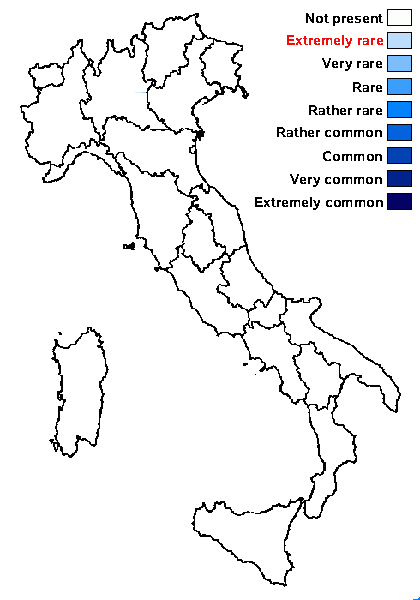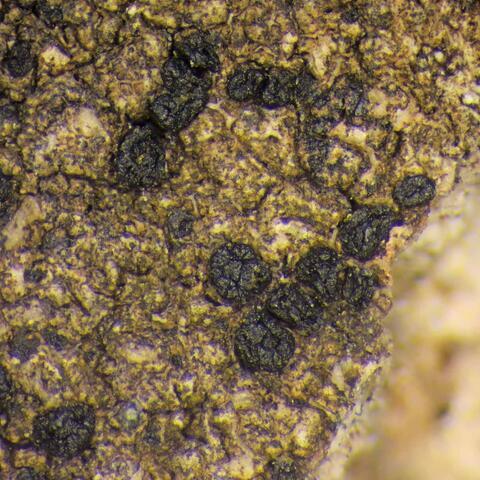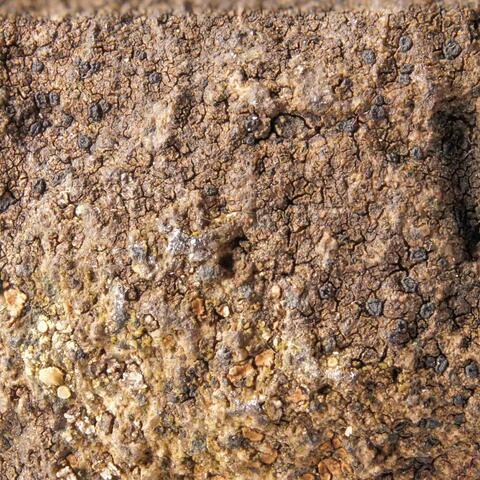Rimularia limborina Nyl.
Flora, 51: 346, 1868
Synonyms: Lecidea inconcinna Nyl.; Lecidea limborina (Nyl.) Lamy; Lecidea subgyratula Nyl.; Lecidea trochodes (Taylor ex Leight.) Cromb.
Distribution:
Description: Thallus crustose, thinly episubstratic (up to 0.15 mm thick), continuous or indistinctly areolate, rarely poorly evident, whitish, pale to dark grey, brown or almost black, matt, sometimes with a dark hypothallus visible between the areoles. Medulla white, I-. Apothecia lecideine, black, circular in outline, 0.3-0.6(-0.8) mm across, mostly sessile and constricted at base, with a flat, but gyrose-umbonate disc and a prominent, radially incised proper margin. Proper exciple 40-100 µm thick laterally, brown-black in outer part, colourless within; epithecium dark brown; hymenium colourless, 85-130(-150) µm high, I+ blue; paraphyses slender, branched and anastomosing, the apical cells hardly swollen; hypothecium dark brown, 60-170 µm high. Asci 8-spored, broadly clavate, the tholus with amyloid flanks and an amyloid cap with vestiges of a narrow, weakly amyloid channel in the upper, central part, Rimularia-type. Ascospores 1-celled, at first hyaline but soon turning brown, broadly ellipsoid to subglobose, (14-)18-28(-40) x (5-)10-18(-21) µm. Pycnidia black, c. 0.1 mm in diam., immersed to half-emergent, the wall dark brown, K-. Conidia short-bacilliform, 3.5-5 x 0.5-1 µm. Photobiont chlorococcoid. Spot tests: thallus, especially medulla, K-, C- or C+ pink, KC- or KC+ pink, P-, UV-. Chemistry: thallus with variable amounts of gyrophoric acid.
Note: on siliceous rocks in irrigated places or other damp situations; widespread in the Holarctic region, in Europe most common in the west and more or less restricted to the montane belt; from the Alps there is a single record only (Switzerland). To be looked for in the Italian Alps.
Growth form: Crustose
Substrata: rocks
Photobiont: green algae other than Trentepohlia
Reproductive strategy: mainly sexual
Most common in areas with a humid-warm climate (e.g. most of Tyrrenian Italy)
Periodically submerged (e.g. in creeks)

Predictive model
Growth form: Crustose
Substrata: rocks
Photobiont: green algae other than Trentepohlia
Reproductive strategy: mainly sexual
Most common in areas with a humid-warm climate (e.g. most of Tyrrenian Italy)
Periodically submerged (e.g. in creeks)

Predictive model
 INDEX FUNGORUM
INDEX FUNGORUM
 GBIF
GBIF



